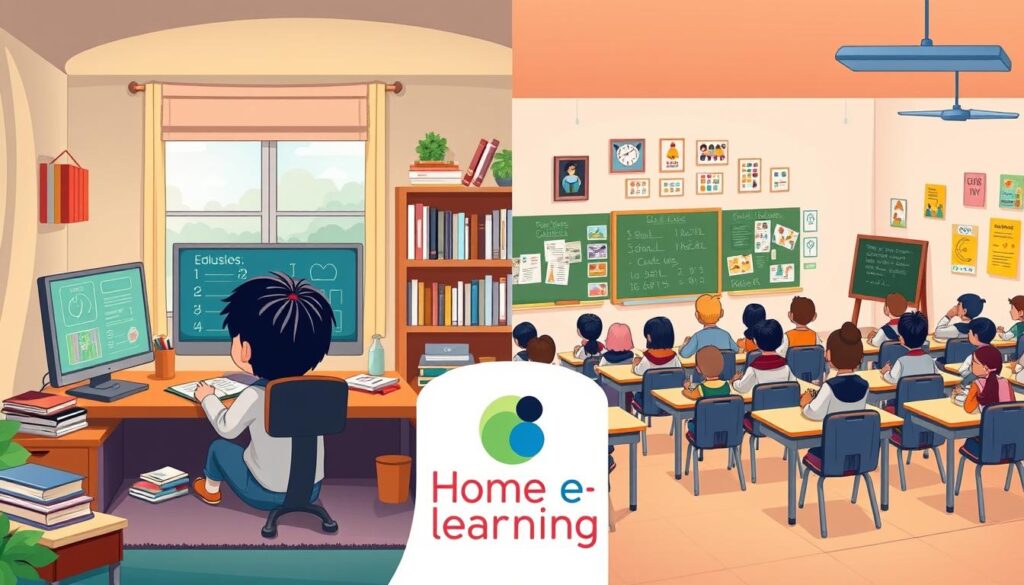Online School vs Traditional School: A Detailed Comparison
As education changes, we wonder about online learning’s benefits. Online vs traditional schooling has its pros and cons. Online schooling is flexible and personal, great for many students. Traditional schooling, on the other hand, offers social interaction and hands-on learning.
To understand the differences, let’s look at the advantages of traditional school vs online learning.
Key Takeaways
- Online schools focus on personalized learning and involve parents more than traditional schools.
- Online schooling is flexible, allowing students to balance school with other activities.
- Traditional schools might not offer the same level of personalized learning as online schools.
- Online education is great for students with busy schedules, like those in sports or family care.
- Online classes start at different times and last for various lengths, giving students more scheduling options.
- Online classes are always open, providing access to libraries and tutors 24/7.
- Online schooling keeps children safe from bullying, a big plus compared to traditional schools.
Key Differences Between Online and Traditional Schooling
When looking at online vs traditional education, it’s key to see the benefits and drawbacks of each. Online learning offers flexibility, fitting up to 70% of learners with busy lives. Traditional schooling, on the other hand, provides a structured setting that suits some students better.
Online schooling is great for personalized learning, helping students with special needs. This is a big plus. Yet, traditional education might lack flexibility and access to resources. But, traditional classrooms use physical textbooks more, about 85%, while online learning uses digital materials around 70%. For more on online school education, check out online school education platforms.

- Learning environment: Online schooling is more flexible, while traditional schooling is structured and interactive.
- Teaching methods: Online schooling uses digital materials and online resources, while traditional schooling relies on physical textbooks and face-to-face interaction.
- Schedule flexibility: Online schooling fits up to 70% of learners with busy or varied schedules, while traditional schooling has a fixed schedule.
Comparing Online vs Traditional Schooling: Core Aspects
When we look at online vs traditional education, several key points stand out. Online schooling offers more flexibility and learning tailored to each student. This is great for those needing special instruction. Yet, traditional schooling has its downsides, like less flexibility and higher costs.
Online education shines for students needing to learn at their own pace. Traditional schooling, on the other hand, works best for those who do well in social settings and need hands-on learning. The online education market is expected to grow fast, reaching US$279.30 billion by 2029.
Here are some important things to think about when choosing between online and traditional schooling:
- Effectiveness: Online schooling is better for those who need flexibility and personalized learning.
- Accessibility: Online education is more accessible for students without access to traditional schools.
- Affordability: Online schooling is often cheaper, with lower costs for tuition and materials.
In the end, the choice between online and traditional schooling depends on what each student needs. By weighing the pros and cons, students can pick the best option for them.
| Aspect | Online Schooling | Traditional Schooling |
|---|---|---|
| Flexibility | High | Low |
| Personalized Learning | High | Low |
| Cost | Low | High |
Conclusion: Making the Right Educational Choice
Choosing between online schooling and traditional schooling is a big decision. It depends on the student’s needs, how they learn best, and their personal situation. Online schooling is flexible and can save money, but traditional schooling offers face-to-face learning and access to physical resources.
Studies show that over 75% of academic leaders think online learning is as good as or better than traditional classes. Yet, 37% of students say online learning is superior, while 15% think it’s not as effective. Also, online classes are often cheaper because they save on travel and teacher costs.
In the end, picking between online and traditional schooling should be a thoughtful choice. It’s important to think about what works best for you, your learning style, and your future goals. By looking at the pros and cons of each, you can choose the best path for your success.







